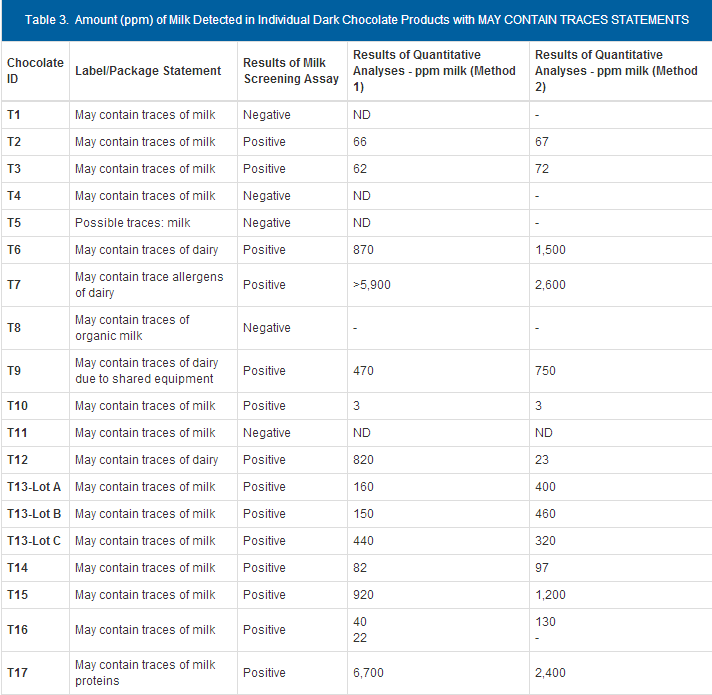Your Location:Home - Hot Topics > - Content
News and Information
A Survey of Milk in Dark Chocolate Products
Time:2017-03-22 11:09:57
Source:FDA

From 2009-2013, approximately 11% of food allergen-related entries in the Reportable Food Registry (RFR) were attributed to undeclared allergens in chocolates and other confections (1). In order to estimate the prevalence of undeclared milk allergen in confections, FDA conducted a limited survey of dark chocolate products for the presence of milk. The products were purchased in the U.S. from September 2013 to September 2014. Of the 94 dark chocolate products surveyed, six contained milk or milk-derived components in the ingredient list, while 88 products were not explicitly labeled as containing milk (did not have milk in the ingredient statement or in a “Contains” statement). In addition to the 94 chocolate products described above, additional lots of four of the dark chocolate products were obtained and analyzed for milk.
All chocolate products were classified into one of five different major categories based on label statement [milk or milk-derived component listed as ingredient (Table 1), advisory statements related to milk (Tables 2-5), dairy-free or lactose-free statements alone (Table 6), vegan statement alone (Table 7), and no statement regarding milk (Table 8)]. Products in the advisory statement category were classified into four subcategories. These subcategories included products with advisory statements alone (Table 2), may contain traces statements (Table 3), advisory + vegan statements (Table 4), and advisory + dairy-free or lactose-free statements (Table 5). Tables 1-8 show the milk concentrations in each dark chocolate product as measured by one or two analytical methods. Limitations of this survey are that only a limited number of dark chocolate products in the U.S. market were surveyed for milk, and that only one sample for most products was analyzed for milk. Thus, this survey only provides a “snapshot” view regarding the presence of undeclared milk in dark chocolate products.
All chocolate products were classified into one of five different major categories based on label statement [milk or milk-derived component listed as ingredient (Table 1), advisory statements related to milk (Tables 2-5), dairy-free or lactose-free statements alone (Table 6), vegan statement alone (Table 7), and no statement regarding milk (Table 8)]. Products in the advisory statement category were classified into four subcategories. These subcategories included products with advisory statements alone (Table 2), may contain traces statements (Table 3), advisory + vegan statements (Table 4), and advisory + dairy-free or lactose-free statements (Table 5). Tables 1-8 show the milk concentrations in each dark chocolate product as measured by one or two analytical methods. Limitations of this survey are that only a limited number of dark chocolate products in the U.S. market were surveyed for milk, and that only one sample for most products was analyzed for milk. Thus, this survey only provides a “snapshot” view regarding the presence of undeclared milk in dark chocolate products.









a. - indicates that the chocolate sample was not analyzed.
b. The > sign indicates that the concentration was greater than the value indicated. In these cases, the samples exceeded the limit of the individual analysis. The limit depended on the recovery obtained during each analysis and the analytical range of the standard curve.
c. The “ADVISORY STATEMENT ALONE” subcategory (Table 2) refers to statements regarding the possible presence of milk, such as “may contain milk (or dairy)”, “made on equipment shared with milk,” “processed in a plant that processes dairy,” or “manufactured in a facility that uses milk.”
d. Multiple values indicate that two or three independent analyses were conducted for verification purposes. The different analytical results are within the acceptable variability associated with the analytical methods.
e. ND indicates that milk was not detected. As indicated in note #1 below, a few randomly selected chocolate products that tested negative in the screening assay were tested with Method 1, Method 2, or both methods to verify that they were indeed negative.
f. Two or three lots of four different chocolate products (A7, A12, T13, F5) were analyzed for milk.
g. Lactose-free chocolates are grouped with dairy-free products although the statement “lactose-free” does not necessarily indicate that the product is free from milk.
Table 1-8 notes:
1. All chocolate products were first screened for the presence of milk using the Neogen Veratox® for Total Milk ELISA (Lansing, MI) test. Chocolate samples testing positive (≥ 2.5 ppm) for milk with the qualitative method were evaluated further to quantify milk concentrations using the Neogen Veratox® for Total Milk ELISA test (Method 1) and the Morinaga (Morinaga Institute of Biological Sciences, Japan) Milk Protein (Casein) ELISA test (Method 2). Chocolate samples labeled as “contains milk” were analyzed for milk concentrations using only one of the ELISA kits (Method 1). A few randomly selected chocolate products that tested negative in the screening assay were tested with Method 1, Method 2, or both methods to verify that they were indeed negative. The limit of detection (LOD) for Method 1 is 2.5 ppm milk, while that for Method 2 is 0.92 ppm milk.
2. ppm = parts per million (microgram/gram)
b. The > sign indicates that the concentration was greater than the value indicated. In these cases, the samples exceeded the limit of the individual analysis. The limit depended on the recovery obtained during each analysis and the analytical range of the standard curve.
c. The “ADVISORY STATEMENT ALONE” subcategory (Table 2) refers to statements regarding the possible presence of milk, such as “may contain milk (or dairy)”, “made on equipment shared with milk,” “processed in a plant that processes dairy,” or “manufactured in a facility that uses milk.”
d. Multiple values indicate that two or three independent analyses were conducted for verification purposes. The different analytical results are within the acceptable variability associated with the analytical methods.
e. ND indicates that milk was not detected. As indicated in note #1 below, a few randomly selected chocolate products that tested negative in the screening assay were tested with Method 1, Method 2, or both methods to verify that they were indeed negative.
f. Two or three lots of four different chocolate products (A7, A12, T13, F5) were analyzed for milk.
g. Lactose-free chocolates are grouped with dairy-free products although the statement “lactose-free” does not necessarily indicate that the product is free from milk.
Table 1-8 notes:
1. All chocolate products were first screened for the presence of milk using the Neogen Veratox® for Total Milk ELISA (Lansing, MI) test. Chocolate samples testing positive (≥ 2.5 ppm) for milk with the qualitative method were evaluated further to quantify milk concentrations using the Neogen Veratox® for Total Milk ELISA test (Method 1) and the Morinaga (Morinaga Institute of Biological Sciences, Japan) Milk Protein (Casein) ELISA test (Method 2). Chocolate samples labeled as “contains milk” were analyzed for milk concentrations using only one of the ELISA kits (Method 1). A few randomly selected chocolate products that tested negative in the screening assay were tested with Method 1, Method 2, or both methods to verify that they were indeed negative. The limit of detection (LOD) for Method 1 is 2.5 ppm milk, while that for Method 2 is 0.92 ppm milk.
2. ppm = parts per million (microgram/gram)



